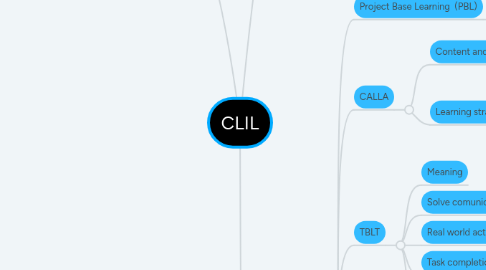
1. Conclusions
1.1. CLIL variants of CBI
1.2. Mediated 4Cs
1.2.1. Content
1.2.2. comunication
1.2.3. cognitive
1.2.4. culture
1.3. Application of communication skills
1.4. Active learners
2. Concepts
2.1. Ana pproach (March, 2002)
2.1.1. Languages
2.1.2. Intercultural knowledge
2.1.3. Understanding
2.1.4. Skills
2.1.4.1. Writing
2.1.4.2. Listening
2.1.4.3. Reading
2.1.4.4. Speaking
2.2. A meaning focused learning (Van de Craen,2006)
2.2.1. Learning subcjet matter
2.2.2. Learning a language
2.3. Evoloving approach (University of cambridge 2010)
2.3.1. Teaching
2.3.2. Learning
2.4. Dual-Focused
2.4.1. Language learning
2.4.2. Content
3. Variants
3.1. Project Base Learning (PBL)
3.1.1. Public product
3.1.2. Presentation
3.2. CALLA
3.2.1. Content and Language Learning
3.2.2. Learning strateges
3.2.2.1. Congnitive
3.2.2.2. Socio-affective
3.2.2.3. Metacognitive
3.3. TBLT
3.3.1. Meaning
3.3.2. Solve comunicative problem
3.3.3. Real world activites
3.3.4. Task completion
3.3.5. Assessment of task
3.4. ESP
3.4.1. Use English
3.4.2. Need to communicate
3.4.3. Particular domain
3.4.4. Areas Expanded
3.4.4.1. (EAP)
3.4.4.2. ESCP
3.4.4.3. EOP
3.4.4.4. EVP
3.4.4.5. EMP
3.4.4.6. EPP
3.4.4.7. ELP
3.4.5. Focuse
3.4.5.1. Language
3.4.5.2. Skills
3.4.5.3. Genres
3.5. EMI
3.5.1. Content Learning
3.5.2. Content Oriented
3.5.3. Language Implicit
3.6. CBI
3.6.1. Based on subject-matter
3.6.2. Authentic language texts
3.6.3. Needs of specific groups of students
